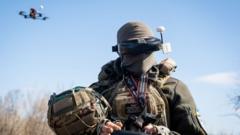In the ongoing conflict in Ukraine, Russian forces have escalated their drone warfare tactics by deploying fibre optic drones, posing significant new challenges for Ukrainian soldiers. This technological evolution demands adaptable strategies amidst devastating impacts on civilian life and military engagements.
The Evolving Drone Warfare: A New Challenge in the Ukraine Conflict

The Evolving Drone Warfare: A New Challenge in the Ukraine Conflict
As Ukraine faces intensified Russian drone attacks, soldiers adapt to the dangers posed by advanced fibre optic drones, marking a troubling shift in modern warfare.
In the Donetsk region's town of Rodynske, the aftermath of a massive 250kg glide bomb serves as a grim reminder of the escalating violence. Just a day after the strike that devastated the town's administrative center and several residential buildings, an acrid smell lingers in the air as artillery echoes nearby. The sound of Ukrainian soldiers scrambling to intercept Russian drones underscores a dire shift in the conflict's dynamics.
Historically, Russian attempts to seize Rodynske from the south have been thwarted by resilient Ukrainian forces. However, a change in tactics has emerged, moving towards encirclements and cutting off supply lines as Russian forces intensify their offensive. This strategy has resulted in significant gains for Russia, marking an alarming shift in the war's tempo.
Our team encounters the immediate threat of a hovering drone while seeking shelter, demonstrating the increasing sophistication and danger of these unmanned aerial vehicles. The widespread deployment of Russian drones, particularly the newly utilized fibre optic variants, presents an unprecedented challenge for Ukrainian defense mechanisms. These drones, capable of delivering precise attacks without fear of electronic jamming, have shifted the battlefield dramatically.
Combatants like Serhii reveal that the intensity of assaults has surged, with a diverse arsenal being utilized to choke off supplies. Waiting for favourable conditions to avoid drone detection has become the norm for Ukrainian forces, complicating troop rotations and deployment strategies. The soldiers have to contend with the psychological strain of being observed, often leading to prolonged periods in their positions amidst relentless enemy activity.
The fibre optic drones, while slower and prone to tangling, have allowed Russia to maintain an operational edge. Ukrainian teams are working to close this technological gap, as the need for countermeasures becomes critical. Yet, the psychological toll on soldiers like Oles and Maksym is palpable, as they recount lengthy stints at the front lines without respite.
Maksym, who balanced life as a father with engaging in combat, embodies the personal sacrifices that countless soldiers are making. His story reflects the poignant reality behind the machinery of war, showcasing the intersection of familial ties and the horrors of frontline reality.
As the war enters its fourth summer, the depletion of Ukrainian manpower against a larger Russian army poses significant challenges to sustaining their defense. The ongoing conflict requires a steady influx of resources, alongside the resilience of the Ukrainian spirit, as they navigate an evolving landscape of warfare marked by technological advancements and the harsh realities of combat.
Historically, Russian attempts to seize Rodynske from the south have been thwarted by resilient Ukrainian forces. However, a change in tactics has emerged, moving towards encirclements and cutting off supply lines as Russian forces intensify their offensive. This strategy has resulted in significant gains for Russia, marking an alarming shift in the war's tempo.
Our team encounters the immediate threat of a hovering drone while seeking shelter, demonstrating the increasing sophistication and danger of these unmanned aerial vehicles. The widespread deployment of Russian drones, particularly the newly utilized fibre optic variants, presents an unprecedented challenge for Ukrainian defense mechanisms. These drones, capable of delivering precise attacks without fear of electronic jamming, have shifted the battlefield dramatically.
Combatants like Serhii reveal that the intensity of assaults has surged, with a diverse arsenal being utilized to choke off supplies. Waiting for favourable conditions to avoid drone detection has become the norm for Ukrainian forces, complicating troop rotations and deployment strategies. The soldiers have to contend with the psychological strain of being observed, often leading to prolonged periods in their positions amidst relentless enemy activity.
The fibre optic drones, while slower and prone to tangling, have allowed Russia to maintain an operational edge. Ukrainian teams are working to close this technological gap, as the need for countermeasures becomes critical. Yet, the psychological toll on soldiers like Oles and Maksym is palpable, as they recount lengthy stints at the front lines without respite.
Maksym, who balanced life as a father with engaging in combat, embodies the personal sacrifices that countless soldiers are making. His story reflects the poignant reality behind the machinery of war, showcasing the intersection of familial ties and the horrors of frontline reality.
As the war enters its fourth summer, the depletion of Ukrainian manpower against a larger Russian army poses significant challenges to sustaining their defense. The ongoing conflict requires a steady influx of resources, alongside the resilience of the Ukrainian spirit, as they navigate an evolving landscape of warfare marked by technological advancements and the harsh realities of combat.




















